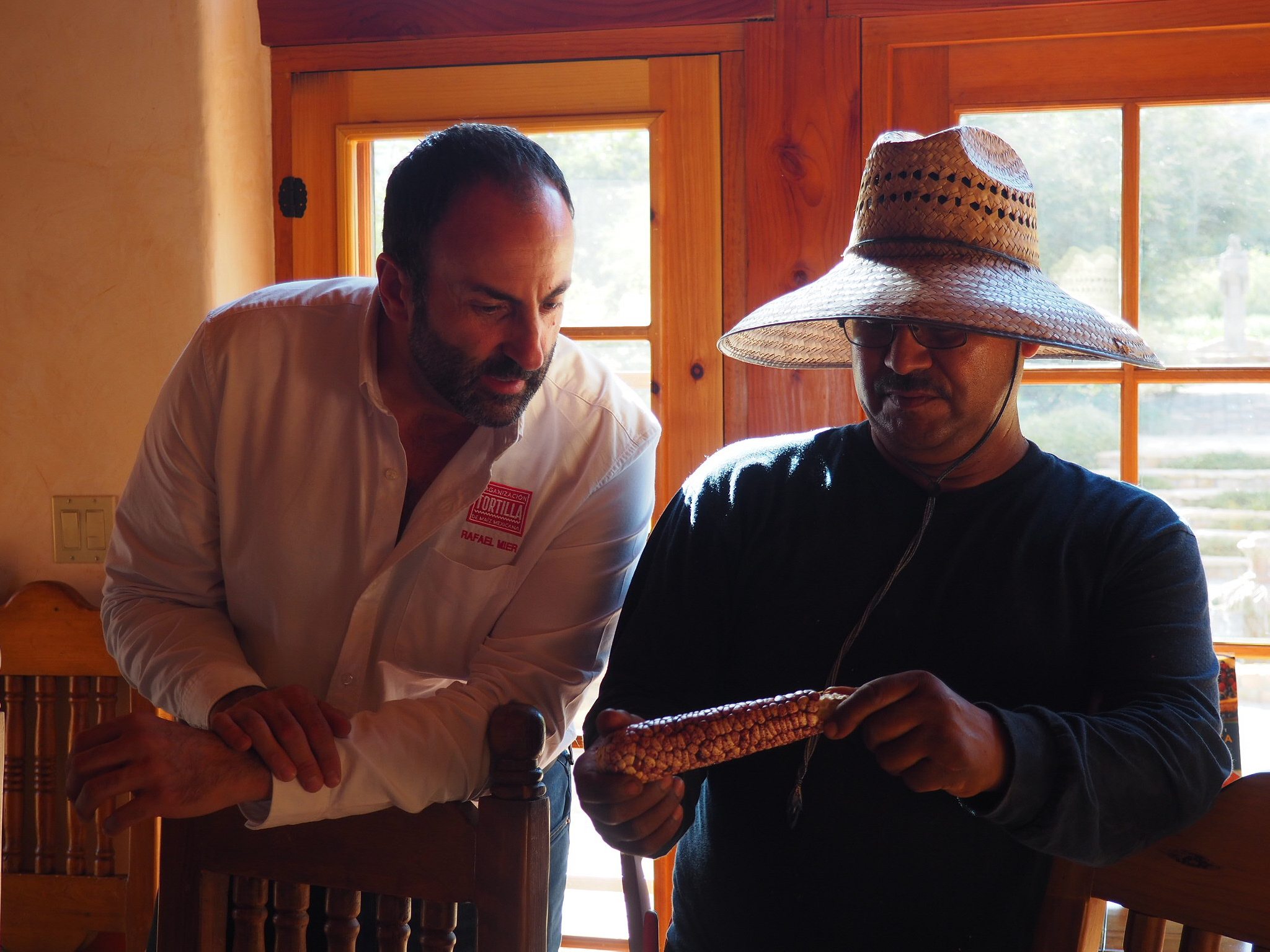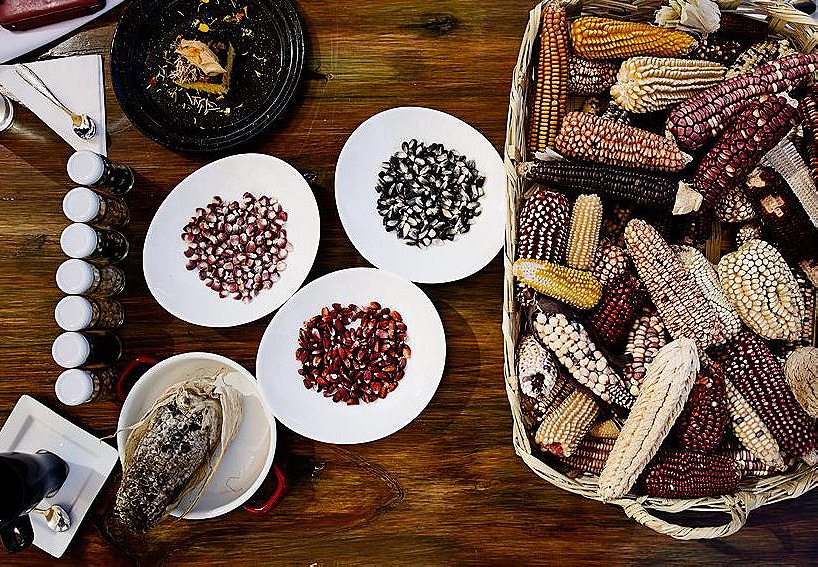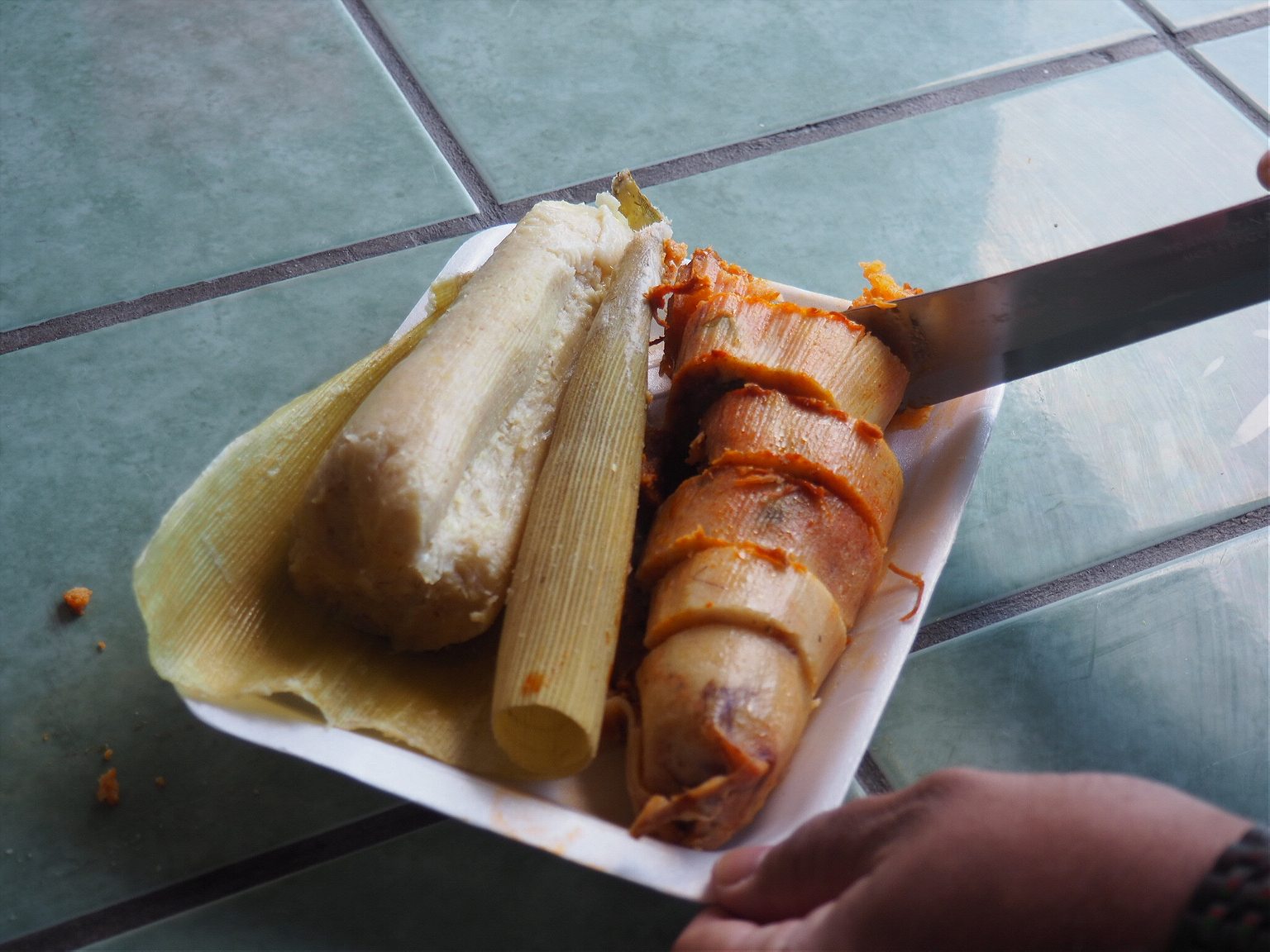One man is intent on preserving the vanishing crops that were once part of the national identity.
“So, you want to know about corn?” Rafael Mier asks, grabbing two suitcases out of the back of a beat-up station wagon. “We are having a crisis in Mexico.”
It is, as it always is, a bluebird day in Baja California, Mexico. When I heard a man was in town who was trying to save Mexican corn, I zipped over the border from San Diego, wondering what about Mexican corn could possibly need saving. I drove down the coast highway and ended up in the garage of an oceanfront luxury high rise in Rosarito, where Mier was staying. After spending more than a week in northwest Mexico, meeting with chefs multiple times a day, he was surprisingly energetic, almost like it was his first day on the job.
Mier is the founder of the Organización de Tortilla de Maíz Mexicana, a mostly one-man activist organization focused on educating Mexicans about good tortillas, which he hopes will save the country’s heirloom corn varieties from extinction. He travels around the country talking to rural village farmers, big-name chefs, government officials, and anyone else who might be wondering what is actually in the tortillas they’re eating. Since tortillas are a Mexican staple food, they are an entry point to learn more about the country’s different corn varieties and its monolithic supply chains. Perhaps the greatest surprise is that this organization needs to exist at all: aren’t “corn” and “Mexico” synonymous? Yes, but also no, because a lot has changed.
Tortilla consumption in Mexico has fallen by 40 percent in the last 30 years, Mier says to our first audience of the day at the Culinary Arts School in Tijuana. While holding up a bag tortillas from a popular store-bought brand, he explains that tortillas people are still eating aren’t high quality, either. Most, including the type he’s holding that he knows are in most peoples’ kitchens, are made with masa harina or maseca. These are powdered mixes made with real corn but also with gums, colorants and preservatives and, in some cases, wheat flour. Googling “how to make corn tortillas” illustrates this: not one English or Spanish-language recipe that comes up calls for using fresh masa.
Real corn tortillas are made with three things
Real corn tortillas, Mier tells everyone multiple times so it sinks in, are made with three things: water, corn, and calcium hydroxide. The corn must be nixtamalized, which is a process that soaks and boils corn in an alkalized solution before being husked. This allows for easy grinding, improvement in flavor and emulsification, ideal qualities for tortilla making. But sourcing the right corn is a problem, too.
Corn cultivation started in México, somewhere between 7,000-11,000 years ago. Historically, all regions grew their own corn for local consumption. Many homes and towns had milpas, or small farms, where they grew the “three sisters” of squash, beans, and corn alongside other crops, creating a nutritious, soil-rich feedback loop that sustained the whole farm. In the last generation, milpas have all but disappeared from many homes.
Changes in the supply chain made processed and prepackaged food cheaper and more convenient than ever, which included tortillas and other corn products. People began relying on store-bought goods to feed themselves and their families. Wealthy and middle class families gladly made the switch. Rural families began to see more cash in their communities, thanks to remittances from relatives in big cities or the United States as well as other governmental social programs, so they started buying packaged food, too.

Since the late 1980s, corn production has been industrialized and centralized, with 44 percent of white corn crops centered in three states: Sinaloa, Jalisco, and Mexico. Distribution is controlled by a few multinational corporations like Cargill or Gramosa. The North American Free Trade Agreement (NAFTA) made the United States’ low corn prices attractive, causing its yellow corn to enter the Mexican market for the first time ever.
American yellow corn, which never used to be eaten in Mexico, now makes up a third of the country’s overall corn supply and is used mostly as animal feed, though it can be found in human food products as well. Local production chains have been so demolished that, during the 2016 Oaxaca teacher protests, corn had to be airlifted into the state to ensure people had enough to eat throughout the blockades. Historically, Oaxaca had been one of the regions where corn domestication was first discovered, but now its people rely on eating corn that comes from points north.
The result of all this change is that 59 varieties of heirloom corn native to Mexico are on the verge of extinction, according to Mier, as are the many regional dishes they are supposed to be made with. Another byproduct are the health issues that have been plaguing Mexico. This substitution of junk food and bad tortillas have had a strong hand in causing Mexico to be ranked second highest in the world for obesity, first for childhood obesity, and one of the world leaders in diabetes diagnoses. Mier says that if people ate real tortillas made from local corn, a lot of these problems will be alleviated.
This information is what Mier brings with him to towns throughout Mexico. Half of the time, he goes alone but sometimes friends come along. He also carries two suitcases filled with dozens of dried heirloom corn ears—which come in a dazzling array of shapes, sizes and colors—to help illustrate the point.
Mier will talk to anyone who wants to learn, a task to which he seems uniquely suited. Always, he is outfitted in a proprietary white collared shirt with the Tortilla de Maíz Mexicana logo. He is calm and authoritative in front of a crowd, seeming more like a friendly uncle ready to dispense life advice than someone who’s about to upend the food system. He is never frustrated at anyone’s lack of knowledge or their questions and never seems annoyed that he is repeating the same information. Sometimes, he gives the exact same talk three or four times in one day. He is a one-man corn-promoting machine.

That corn is so endangered is news to many Mexicans, many of whom don’t have a deep understanding of the seismic supply shift that has occurred behind their backs as it happened only within the last generation. Mier didn’t realize it either. As we travel to his first presentation of the day, I ask how he got involved with corn activism. He lights up and explains that his journey started at least five years ago, when he began tending to his own land in Mexico state. He thought to plant popcorn, an ancient variety known as palomero toluqueño, when he realized nobody had any seeds he could use.
“Town by town, I looked for these seeds, studying where they might be located. I started driving to many states in Mexico trying to find them, but there were none. It was so disappointing. One by one, I had people telling me that their grandparents planted them, but not anymore, and they lost the seeds awhile ago,” Mier laments. “ I visited a very old lady who recalled planting them herself, but there was a big frost many years ago that caused her to lose all her seeds. After that, she started buying tortillas.”
“Around the same time, I also decided I wanted to plant blue corn, which is common to the state of Mexico. No farmers near me had any seeds saved,” he continues. “That was one of the reasons I started the foundation: I never realized corn was actually endangered. It was shocking to find out that ancient popcorn, one of the most common varieties, was about to become extinct and it was frustrating to not be able to buy seeds from a catalog. How could this happen to corn in Mexico? We’ve been planting corn for, it’s thought, 11,000 years. The government should be able to promote and help farmers everywhere in the country, because there’s nothing new about corn. We know everything already. It should be organized better. I had this feeling that we needed to start something.”
Though Mier spent much of his adult life working in a family furniture business, most recently as its Chief Financial Officer, he says he always felt a pull between his “two sides,” so he has been running Organización de Tortilla de Maíz Mexicana for the last two years as a side project, which he recently decided will become his full-time job.
After his presentation at Tijuana’s Culinary Arts School, which is credited with creating the lauded Baja California cooking culture that made the state’s chefs a target for Mier’s efforts, we landed at Rancho La Puerta. “The Ranch,” as enthusiasts call it, is a tony spa retreat in the town of Tecate that sits directly on the border fence with the United States and San Diego County. With a vegetarian food program, a cooking school and a resort owner who just happened to be obsessed with heirloom corn, he had his most captive audience yet.
As he passed around the ears—some with white and pink speckled dots, others with pearlized black kernels—everyone ooh-ed and aah-ed at the possibilities. It’s hard not to wonder what that corn would taste like, say, in tortilla form, doused in salsa and stuffed with meat and cheese. That is precisely Mier’s goal.
Mayan legend attributes the creation of man to corn
His message generally strikes a chord. In Mexico, it is said that, “sin maíz no hay país”: without corn there is no country. Mayan legend attributes the creation of man to corn. But people don’t have an easy way of getting good corn products. They may not have the time, interest or ability to start farming. Their local tortilleria, Mier says, doesn’t have to disclose what is in its tortillas and likely isn’t using nixtamalized corn. Store bought tortillas are the default for most, offering little in terms of choice of quality.
Still, Mier says he can see the spark in their eyes when he asks them to recall family memories, whether about corn or specific dishes that may have been lost over time. “In Ensenada, someone said she remembered her grandma grew heirloom corn in their backyard. In an indigenous village in Mexico state, I was talking to a woman about pinole [a mixture of ground, roasted corn with various spices] during a discussion about traditional dishes. Then, she realized, she never made it for her children despite eating it all the time herself. She was shocked! She never thought about it. So, that day, we made the first pinole for her children, who were 18 and 20—not children anymore. I couldn’t believe they’d never had it,” he remembers.
Denise Roa, the chef at Rancho La Puerta, commented that she didn’t know anywhere she could buy fresh masa, so she relied on store-bought tortillas. This is an echo Mier hears from chefs throughout the country, even at Mexico City’s finest restaurants, he says. It’s a particular crime considering how Mexican food—especially the high-end kind—has swept the globe in recent years. One chef, in particular, has paid attention to Mier’s efforts. Rene Redzepi of Noma in Copenhagen heard about his work and tapped him to give a presentation to him and his staff during his pop-up in Tulum in late spring 2017. Mier says that the kitchen staff he meets hardly ever know how to make fresh tortillas, much less about different heirloom corn varieties. Ever the optimist, it never fails to amaze him.

Mier doesn’t have any ready-made solutions on hand. His goal is to let people know that their heritage is in danger, and he expects that, from there, people will begin to change their habits. He would love to see seed catalogs, like there are in the United States, and dreams of starting one. He wants to connect small farmers and chefs in the hope of creating a supply chain based on seasonality and suitability. As of August 2017, the Mexican government approved Mier’s foundation status, which means Organización de Tortilla de Maíz Mexicana will be able to receive donations and grants. And he was eventually able to find the popcorn seed he needed from a farmer in Mexico state—after planting, it’ll be part of his 2017 personal harvest as well as the first harvest of this variety in 60 years, Mier believes. He is also encouraged by a particular recent victory for agricultural activists: a 2013 lawsuit filed against Monsanto was recently upheld in Mexican court this past January. It bans the company, for now, from planting GMO corn, though such corn enters the food system anyway due to American imports.
While driving, we passed a building with “100% elote” painted on its wall, so we stopped. As Mier sampled the owner’s tamales, he chatted with her about how she makes them and went back for seconds. He was satisfied that she used only corn, though he knew it was either the standardized white corn or imported American corn. I got the sense that half of his excitement was due to the fact that he knew something she didn’t: that as good as her tamales were, one day he’d blow everyone’s mind with the fact they could be even better. But for now, Rafael Mier remains Mexico’s premier corn evangelist, going from door to door with his two suitcases, reminding Mexicans of their birthright one ear of corn at a time.
Top image: Sam Fentress/Wikipedia Commons